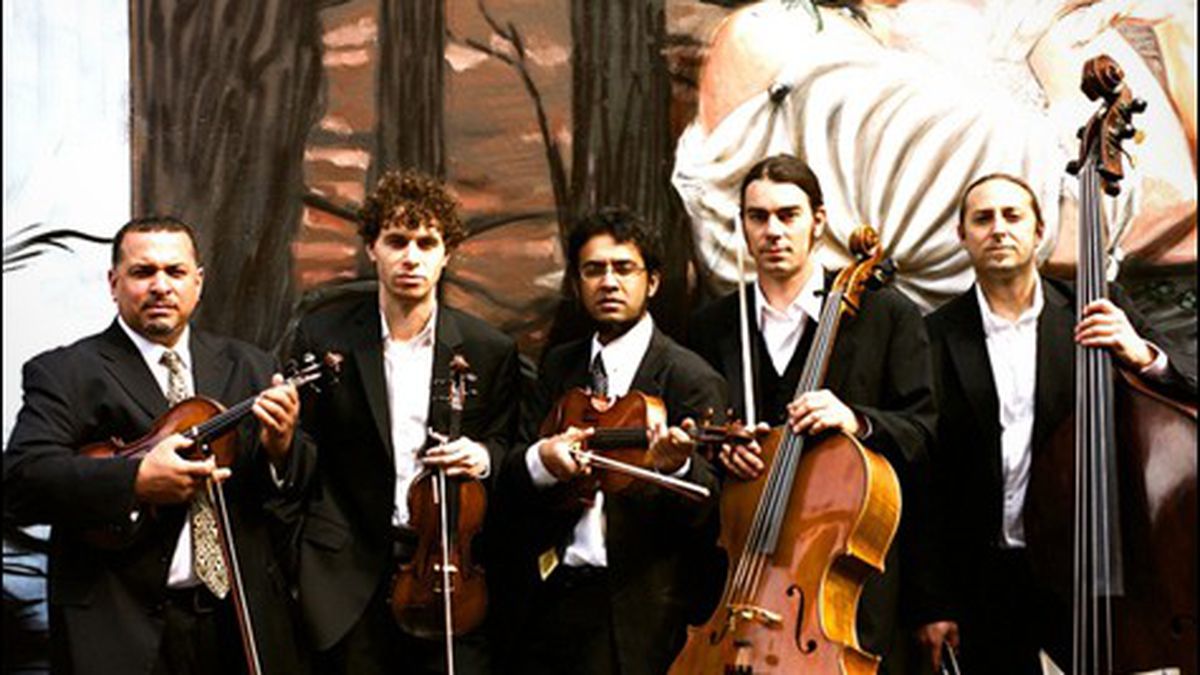It was somewhat brazen for violinist Adam Scow and viola player Charith Premawardhana to ascribe the name “Classical Revolution” to a loose confederation of chamber musicians who meet every Monday night in San Francisco’s Mission district. If anything, Scow says the name has more to do with its venue — The Revolution Cafe — than with the group’s raison d’être. But there is a populist cast to Classical Revolution, which formed in 2006 and now boasts thirty chapters internationally, and is on its way to becoming a nonprofit. It was particularly apparent last Saturday, when one of the group’s offshoots, the Musical Art Quintet, threw a free concert in the lobby of Brava Theater. It was part of a series of events the group is producing, with a grant from the Zellerbach Foundation, to help liberate chamber music from the rarefied world of fancy mustard and powdered wigs. Scow’s goal is to make it accessible.
That’s something that he and the other musicians take to heart. An hour before showtime, they did a little impromptu outreach to get people in the door. Violinist Jory Fankuchen stood at the entrance, playing arpeggios. Percussionist Javier Navarette sat on the sidewalk with his congas and began drumming — within minutes he’d amassed a small crowd. Bassist and bandleader Sascha Jacobsen politely accosted passersby. A blind woman regarded him skeptically. “Can I bring my kids?” she asked. “Is it appropriate for children?”
The crowd that gradually trickled in was exactly the kind that Classical Revolution envisions — meaning conspicuously heterogeneous. There were kids, Boomers with North Face backpacks, people clutching coffee cups, and a man wearing a red beret. The musicians set up in a corner, wedged between the women’s restroom and a piano. Premawardhana set up a laptop to stream the concert; Jacobsen arranged sheet music on a table. Audience members sat on the sloped part of the floor outside Brava’s main theater. At 6 p.m. the quintet members (Jacobsen, Premawardhana, Fankuchen, violinist Anthony Blea, and cellist Shain Carrasco) had all arrived, along with two guests — Navarette and Scow. Jacobsen addressed the crowd: “Thank you for coming,” he said, in a faintly Russian accent that belied his Humboldt County origins. “We are the Musical Art Quintet.”
Like the other members of Classical Revolution, Jacobsen is a master composer and instrumentalist. He started playing upright bass at sixteen, earned a master’s degree from the University of Southern California, taught at several institutions, and currently serves in professional orchestras — on Saturday, he’d rushed in from a gig playing for the ABBA-inspired musical Mamma Mia! He’s also descended from a lofty musical pedigree. The name Musical Art Quintet, in fact, derives from a group his great-grandfather formed in New York, after immigrating there from Russia and opening a violin shop in a Jewish tenement. With all that said, he’s remarkably unassuming, even as a bandleader. There’s no pomp and circumstance to a Musical Art production. The guys — weirdly, they’re all men — arrive in untucked shirts and jeans, and adapt to whatever environment Jacobsen puts them in. Absent the drums, Jacobsen and Carrasco slap a beat on their string instruments.
The show at Brava had all the formality of a jam session, but for the sublime intensity of the music. Musical Art isn’t strictly chamber; it’s also steeped in influences from Argentine tango and American jazz, which makes the style not only more open, but also more urbane. The group kicked off with a fairly traditional tango called “El Viejito,” then moved on to the piece “Luna Llena,” which is a little more telling of the group’s sensibility. “Luna” has a cha-cha-cha rhythm and a burst of splashy chords that sound more like the stuff of jazz — “There’s some Coltrane changes in there,” Jacobsen explained later. The beat was so catchy that two children in the audience started shaking their hips.
In the course of ninety minutes, Musical Art Quintet ran through mostly pieces from its new album, Nuevo Chamber. The group played cha-chas, a waltz, a blues with a New Orleans second-line feel, a couple “electro tangos” that included laptop beats, and even a Seventies salsa tune originally scored for a fourteen-piece orchestra, which Jacobsen had readapted — the violins played the sax and cowbell parts; the viola subbed for a piano. Even by salsa standards, it was sexy.
By the end, the crowd had increased by at least a factor of three — people spilled out across the carpet and surrounded the concession stand. Scow explained the mission of Classical Revolution and announced the group’s intent to offer free concerts throughout the Bay Area. “Noe Valley!” someone shouted in the audience. “Bayview!” another echoed. “Oakland!” The other musicians smiled sheepishly. They’d launched their group as a muse, and become de facto arts boosters in the process. Well, that’s certainly revolutionary.














